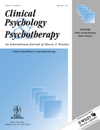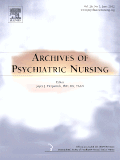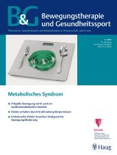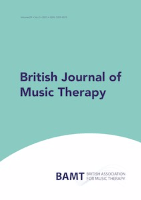
AMERICAN JOURNAL OF DANCE THERAPY
Scope & Guideline
Transforming Healing Through Movement
Introduction
Aims and Scopes
- Dance/Movement Therapy Research and Practice:
The journal consistently publishes research exploring the efficacy of dance/movement therapy across diverse populations, including children, trauma survivors, and individuals with specific mental health challenges. This research often employs qualitative and quantitative methodologies to evaluate therapeutic outcomes. - Cultural Competence and Diversity in Therapy:
A significant focus is placed on cultural sensitivity and the incorporation of diverse perspectives in dance/movement therapy practice. This includes exploring the experiences of marginalized communities and promoting anti-racist approaches within therapeutic contexts. - Interdisciplinary Approaches:
The journal highlights the integration of dance/movement therapy with other therapeutic modalities, such as cognitive behavioral therapy and physical therapy. This interdisciplinary focus enhances the understanding of how movement can support holistic healing. - Embodied Research and Practice:
The journal emphasizes the importance of embodied knowledge in therapeutic practices, encouraging research that examines the somatic and experiential aspects of therapy through movement. - Community and Reconciliation:
Recent publications illustrate a commitment to exploring community-based interventions and the role of dance/movement therapy in fostering social reconciliation and healing, particularly in vulnerable populations.
Trending and Emerging
- Integration of Spirituality in Therapy:
Recent publications highlight the growing recognition of spirituality as a significant component of therapeutic practice, particularly in dance/movement therapy. This trend emphasizes the holistic nature of healing and the importance of addressing spiritual dimensions in therapy. - Focus on Marginalized Communities:
There is an increasing emphasis on the experiences of marginalized populations, such as migrant women and individuals in the criminal justice system. This focus on inclusivity and social justice reflects a broader cultural awareness and the need for therapeutic practices that resonate with diverse communities. - Health Outcomes Related to Physical Therapy and Dance:
Emerging research is exploring the intersection of dance/movement therapy and physical health outcomes, such as heart rate variability and fall prevention. This trend underscores the importance of physical well-being in therapeutic contexts and the potential for dance to contribute to overall health. - Trauma-Informed Approaches:
The journal is increasingly publishing work that incorporates trauma-informed frameworks within dance/movement therapy. This focus is crucial as it aligns with contemporary understandings of mental health and the impact of trauma on individuals. - Community Healing and Social Reconciliation:
There is a notable trend towards exploring the role of dance/movement therapy in community healing and reconciliation processes. This emerging theme highlights the potential for dance to foster connections and support collective healing in the face of societal challenges.
Declining or Waning
- Traditional Dance Forms in Therapeutic Contexts:
There appears to be a decreasing emphasis on the use of traditional dance forms as standalone therapeutic interventions. Recent literature has shifted towards more integrative and interdisciplinary approaches rather than relying solely on established dance modalities. - Generalized Populations:
Research focusing on generalized populations without specific therapeutic needs is becoming less common. The current trend favors targeted studies that address specific issues such as trauma, addiction, or cultural identity, reflecting a movement towards more personalized therapeutic practices. - Historical Perspectives on Dance Therapy:
While historical context is important, there has been a noticeable reduction in articles focused exclusively on the historical evolution of dance/movement therapy. The journal's current trajectory favors contemporary applications and innovative practices over historical analysis.
Similar Journals

CLINICAL PSYCHOLOGY & PSYCHOTHERAPY
Uncovering New Frontiers in Psychotherapeutic TechniquesClinical Psychology & Psychotherapy is a leading journal in the field of clinical psychology, published by Wiley. With its ISSN 1063-3995 and E-ISSN 1099-0879, this esteemed publication has played a pivotal role in disseminating groundbreaking research and innovative clinical practices since its inception in 1993. Nestled within the United Kingdom, the journal maintains a rigorous academic reputation, showcased by its Q1 quartile rankings in Clinical Psychology and Medicine (miscellaneous) as of 2023, and an impressive Scopus ranking at the 84th percentile in its category. The journal's commitment to advancing the field is reflected in its wide array of articles that encompass a diverse spectrum of psychotherapy methodologies, evidence-based treatment approaches, and the latest psychological findings, making it an essential resource for researchers, professionals, and students alike. Although it is not an Open Access journal, the high impact factor and editorial standards affirm its position as a cornerstone of psychological literature. Access to its rich repository of knowledge provides invaluable insights for those dedicated to enhancing clinical outcomes and understanding psychological well-being.

ARCHIVES OF PSYCHIATRIC NURSING
Elevating standards in psychiatric nursing scholarship.Archives of Psychiatric Nursing, a prestigious journal published by W.B. Saunders Co. - Elsevier Inc., serves as a vital resource in the field of Psychiatry and Mental Health. With an ISSN of 0883-9417 and E-ISSN 1532-8228, this peer-reviewed publication has been contributing to the academic discourse since its inception in 1987 and is set to continue until 2024. Ranked in the Q2 category for Psychiatry and Mental Health in 2023 and holding a significant position as rank 14 out of 45 in the Nursing - Psychiatric Mental Health category, it positions itself within the 70th percentile, showcasing its influence and importance in the domain. Though not an open-access journal, it provides a range of access options for readers seeking advanced research and insights. As a dynamic platform, the journal is dedicated to expanding knowledge and promoting best practices among psychiatric nursing professionals, researchers, and students, making it an essential tool for those engaged in mental health care and research.

JOURNAL OF CONTEMPORARY PSYCHOTHERAPY
Bridging Theory and Practice in Mental HealthJournal of Contemporary Psychotherapy is a prestigious academic journal dedicated to exploring the evolving practices and theories in the field of psychotherapy. Published by Springer International Publishing AG, the journal has been a vital resource since its inception in 1968, showcasing works that bridge the gap between clinical psychology and psychiatry. With an impressive impact factor reflected in its Q2 ranking in both Clinical Psychology and Psychiatry and Mental Health, the journal caters to a diverse audience of researchers, practitioners, and students keen on advancing their understanding of contemporary therapeutic approaches. Though it operates under a traditional subscription model, the journal is committed to disseminating high-quality research that contributes to the ongoing dialogue in mental health treatment and practice. By focusing on innovative methods and empirical studies, Journal of Contemporary Psychotherapy plays a crucial role in shaping future directions in psychotherapy and mental health care.

Drama Therapy Review
Exploring the Healing Power of PerformanceDrama Therapy Review, published by INTELLECT LTD, stands as a pivotal scholarly journal within the fields of Complementary and Manual Therapy and Visual Arts and Performing Arts. With an ISSN of 2054-7668 and an E-ISSN of 2054-7676, this journal is esteemed for its rigorous examination of the therapeutic applications of drama and performance in clinical settings. Operating since 2019 and with a converged publishing timeline extending to 2024, it has rapidly established itself, achieving a remarkable Q1 ranking in the Visual Arts and Performing Arts category and a Q2 ranking in Complementary and Manual Therapy as of 2023. With Scopus rankings placing it in the top percentiles within its respective fields, Drama Therapy Review offers valuable insights, research findings, and case studies that not only enrich academic discourse but also provide practical applications for therapists and practitioners. The journal is an essential resource for those engaged in the dynamic intersection of the arts and health, promoting innovative approaches to therapy and well-being.

Bewegungstherapie und Gesundheitssport
Innovating Health Solutions Through Movement ScienceBewegungstherapie und Gesundheitssport, published by GEORG THIEME VERLAG KG, is a distinguished journal primarily focused on the fields of movement therapy, health sports, and rehabilitation sciences. With a commitment to fostering knowledge dissemination and innovation in promoting physical health and well-being, this journal serves as a vital resource for researchers, health professionals, and students interested in the intersection of exercise and therapy. While currently not offering an open access model, it maintains a robust impact on academic discourse, supported by rigorous peer-reviewed research that spans diverse methodologies and interdisciplinary approaches. The journal invites high-quality contributions that explore the efficacy of movement therapies, the impact of physical activity on health disorders, and emerging trends in health promotion strategies, thereby enhancing the understanding of physical well-being's role in society.

Australian and New Zealand Journal of Family Therapy
Pioneering new frontiers in family therapy and social sciences.Welcome to the Australian and New Zealand Journal of Family Therapy, a distinguished publication dedicated to advancing the field of family therapy and social sciences since its inception. Published by WILEY, this journal provides an invaluable platform for researchers, practitioners, and students to disseminate and explore innovative therapy practices and theoretical insights. With a strong history of publication spanning from 1979 to 2024, the journal currently holds an impressive Q2 ranking in Sociology and Political Science and a Q3 ranking in Psychology (miscellaneous) for 2023, reflecting its impactful contributions to the academic community. Although it operates under a traditional access model, the journal's commitment to quality and relevance ensures a wide reach, appealing to a diverse audience invested in the ongoing evolution of family therapy and related disciplines. For those looking to stay at the forefront of research and practice in this vital field, the Australian and New Zealand Journal of Family Therapy stands as a leading source of knowledge and inspiration.

Revista de Psicoterapia
Unveiling New Horizons in Psychological PracticeRevista de Psicoterapia is a prominent scholarly journal dedicated to the fields of psychotherapy and psychological practice, published by REVISTA PSIQUIATRIA & PSICOLOGIA HUMANISTA, S L. With its ISSN 1130-5142 and E-ISSN 2339-7950, the journal serves as a vital resource for researchers, practitioners, and students who seek to explore innovative therapeutic practices and advancements in the field of mental health. Although specific impact metrics like HIndex or Scopus rankings are currently unavailable, the journal is recognized for facilitating meaningful discourse on psychotherapy, showcasing empirical research, clinical studies, and theoretical advancements. It aims to promote evidence-based practices and interdisciplinary collaboration in the mental health community. As an essential platform in psychotherapy research, Revista de Psicoterapia fosters an understanding of psychological phenomena while addressing contemporary challenges in psychotherapy, making it indispensable for anyone committed to the advancement of psychological well-being.

Psychotherapie
Fostering Collaboration Between Theory and PracticePsychotherapie is a pivotal academic journal dedicated to the exploration and advancement of clinical psychology, published by the esteemed Springer. Since its inception in 2022, this journal has established a significant footprint in the field, currently positioned in the Q3 category for Clinical Psychology in 2023, as well as being recognized for its Scopus ranking within the top half of its category. This valuable resource features a broad scope of peer-reviewed articles aimed at both theoretical and practical developments in psychotherapy, making it a vital platform for researchers, professionals, and students alike. While the journal is not open access, it maintains a commitment to disseminating high-quality research that can influence best practices and contribute to the ongoing discourse in psychology. The journal's editorial objective is to connect scientific research with clinical practice, ensuring insights garnered from emerging studies are readily available to enhance therapeutic outcomes. Located in the USA with a strong presence in Germany, Psychotherapie promises to be an essential resource for anyone keen on innovative therapeutical approaches and psychological research.

British Journal of Music Therapy
Exploring innovative pathways in music therapy.British Journal of Music Therapy, published by SAGE Publications Ltd, is a leading peer-reviewed journal dedicated to the field of music therapy. With a commitment to advancing knowledge and practice, this journal serves as a vital platform for researchers, professionals, and students interested in the therapeutic applications of music. The British Journal of Music Therapy publishes original research, reviews, and case studies that highlight innovative methodologies and outcomes in music therapy interventions. It is recognized for its robust academic rigor and contributes significantly to enhancing the understanding of music’s role in health and wellbeing. While currently not open access, the journal ensures that its content is relevant and accessible, providing valuable insights into how music therapy can transform lives. With its ISSN 1359-4575 and E-ISSN 2059-9773, the journal continues to cultivate a scholarly community focused on the impactful ways music can heal and support individuals across various settings.

International Journal of Art Therapy
Discovering Art's Role in Emotional ResilienceThe International Journal of Art Therapy, published by Taylor & Francis Ltd, stands at the forefront of interdisciplinary exploration within the fields of clinical psychology and rehabilitation. With a strong impact factor and recognized as a Q2 journal in Clinical Psychology and Q1 journal in Rehabilitation as of 2023, this journal emphasizes the multifaceted role of art therapy in promoting mental health and emotional well-being. Since its inception in 2010, it has rapidly gained recognition, ranking 20th out of 161 in the Medicine - Rehabilitation category and 70th out of 311 in Psychology - Clinical Psychology according to Scopus, boasting stellar percentiles of 87th and 77th respectively. Scholars, practitioners, and students will benefit from its rich array of research articles, reviews, and case studies that illuminate the therapeutic potential of art as a transformative tool. While the journal is not open access, its contributions are invaluable for anyone looking to expand their understanding of art therapy’s impact in clinical settings.